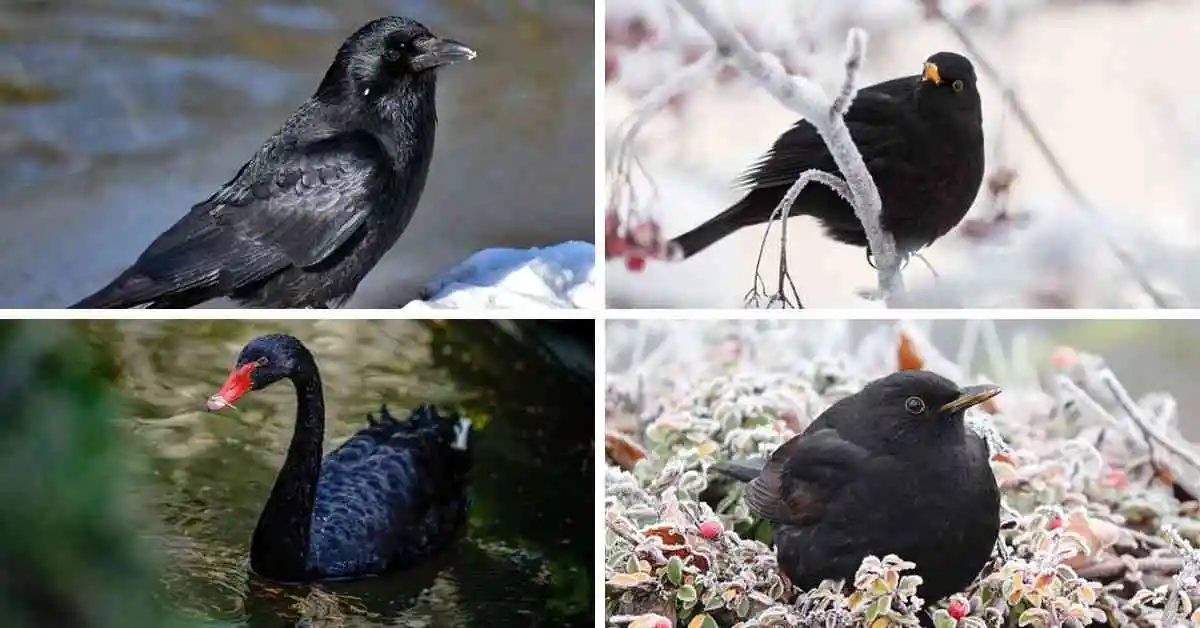
Black birds in Florida are one of the prettiest birds in the world. Whenever we see a blackbird, our minds tell us about something new birds. Most of the black birds of Florida are very common.
Some of the most beautiful and fascinating black birds in Florida include the Grackles, Rust Blackbird, Shiny cowbird, Blak vulture, and Magnificent Frigatebird, among others.
In this guide, I will introduce you to 15 unique blackbird types living in Florida. These blackbirds have unique colors and characteristics.
15 Unique Black Birds in Florida:
More than 40 blackbirds are found in Florida, but some species are white and black, and some are orange-black, red-black, and dark-black.
In this article, we choose only 15 dark black birds commonly found in Florida. The 15 blackbirds are:
- Black Vulture
- Magnificent Frigatebird
- Boat-tailed Grackle
- Brewer’Brewer’sird
- Rusty Blackbird
- American Crow
- Shiny cowbird
- Great-tailed grackle
- common grackle
- Common Gallinule
- Double-crested Cormorant
- Red-winged blackbird
- Anhinga
- American Coot
- Smooth-billed Ani
The blackbirds in Florida can be found in various habitats, from wetlands to urban areas. So ready to discover with us the 15 black birds found in Florida.
1. Black Birds in Florida: Black Vulture
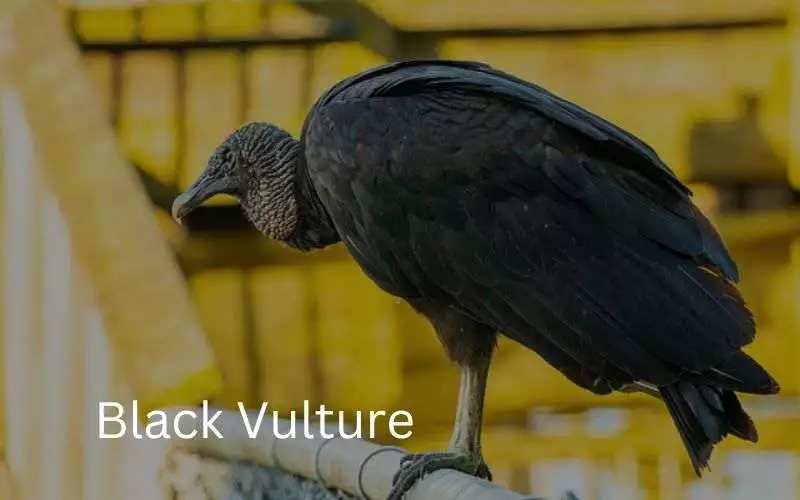
Black vultures are large black birds found in Florida. They have featureless heads and short, broad wings designed for soaring and gliding.
Quick Facts
- Scientific Name: Coragyps atratus
- Length: 22-29 inches
- Wingspan: 52-66 inches
- Weight: 3.5-6.6 pounds
- Lifespan: Up to 25 years in the wild
Identification Features
Physical Characteristics:
- Head: Featherless, gray-black wrinkled skin
- Body: All-black plumage with a silky sheen
- Wings: Short and broad with silvery-gray flight feathers
- Tail: Short and square-shaped
- Eyes: Dark brown
- Feet: Grayish-white with strong talons
How to Distinguish from Similar Species:
- Shorter tail than a Turkey Vulture
- Holds wings flat while soaring (vs. Turkey Vulture’s V-shape)
- No redhead like Turkey Vulture
- More compact body shape
- Direct flight pattern
Habitat & Distribution
Preferred Locations in Florida:
- Central Florida:
- Orlando urban areas
- Lake Apopka North Shore
- Ocala National Forest
- South Florida:
- Everglades National Park
- Big Cypress National Preserve
- Urban areas around Miami
Typical Environments:
- Open countryside
- Suburban areas
- Landfills
- Agricultural fields
- Coastal regions
- Wooded areas near open spaces
Behavior
Daily Activities:
- Morning:
- Warm up in the sun
- Begin soaring by mid-morning
- Search for food in groups
- Afternoon:
- Peak soaring activity
- Social gathering at feeding sites
- Group roosting begins
- Evening:
- Return to communal roosts
- Social interaction with group members
- Settle in trees for the night
Feeding Habits:
- Primary Diet:
- Carrion (dead animals)
- Small live prey
- Food waste at landfills
- Hunting Technique:
- Relies on sight to locate food
- Follows other vultures to food sources
- Uses group feeding strategy
Social Behavior:
- Highly gregarious
- Forms strong family bonds
- Roosts in large communal groups
- Demonstrates complex social hierarchies
Best Times to Observe
Prime Viewing Locations:
- Paynes Prairie Preserve State Park
- La Chua Trail
- Observation tower
- Bison overlook
- Everglades National Park
- Shark Valley
- Anhinga Trail
- Pa-hay-okee Overlook
- Urban Locations
- Industrial areas
- Shopping center rooftops
- Cell tower locations
Photography Tips
Camera Settings:
- Shutter speed: 1/1000 or faster
- Aperture: f/5.6-f/8
- ISO: 400-800 in good light
- Focus mode: AI Servo/Continuous
Best Angles:
- Early morning silhouettes
- Banking turns in flight
- Ground-level feeding shots
- Group interaction scenes
Conservation Status
Current Population:
- Stable and increasing in Florida
- Protected under the Migratory Bird Treaty Act
Threats:
- Vehicle collisions
- Lead poisoning from ammunition in carrion
- Habitat loss in some areas
Conservation Efforts:
- Protected roosting site designation
- Public education programs
- Wildlife corridor preservation
[Related internal link: Complete Guide to Florida’s Vulture Species] [External link: Florida Fish and Wildlife Conservation Commission – Black Vulture]
Fun Facts
- Can live up to 25 years in the wild
- Lacks a sense of smell (unlike Turkey Vultures)
- Forms long-term pair bonds
- Uses group defense strategies
- Can’t vocalize (only hisses and grunts)
Viewing Tips for Beginners
- Look for groups circling in thermals
- Check open areas after sunrise
- Visit landfills (with permission)
- Watch for roosting sites near water towers
- Observe from a respectful distance
2. Magnificent Frigatebird
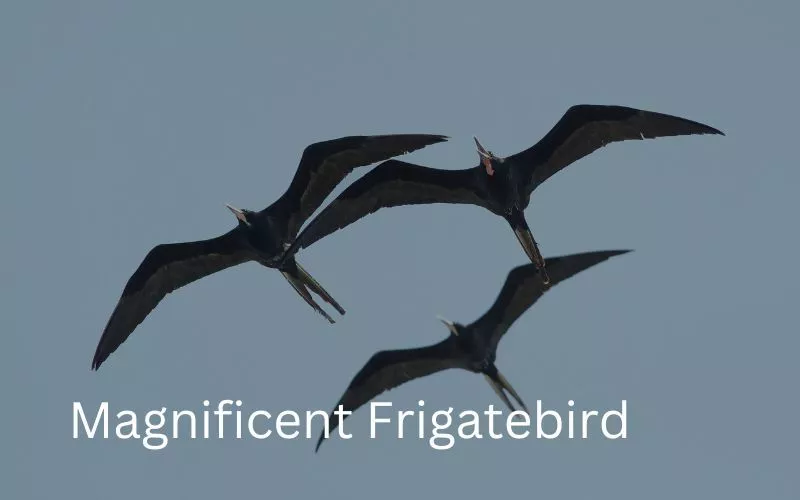
| Characteristic | Description |
|---|---|
| Color | Mostly black, males have a red throat pouch |
| Size | About 39 inches tall |
| Wingspan | 85–95 inches wide |
| Beak | Long, hooked beak |
| Habitat | Coastal areas, often near islands |
| Diet | Primarily black, males have a red throat pouch |
| Behavior | Generally silent, with some low rattling sounds |
| Flight Style | Graceful, with long glides and few wingbeats |
| Voice | Generally silent, some low rattling sounds |
| Common in Florida? | Yes, especially in the Florida Keys and coastal regions |
The Magnificent Frigatebird is a large seabird in the family Fregatidae. It has a distinctive appearance: a long wingspan, a deeply forked tail, and a large beak.
Males have a black body with a red throat punch, while females are black with a white breast and throat.
Size: The magnificent frigatebird is one of the largest seabirds in the world, with a wingspan of up to 7.5 feet (2.3 meters) and a length of up to 45 inches (115cm). Males are slightly larger than females.
Habitat: The Magnificent Frigatebird breeds in trees in Florida, the Caribbean, and the Pacific coast of America. It is found in tropical and subtropical waters of the Atlantic, Pacific, and Indian Oceans.
Diet: The magnificent Frigatebird is a predatory bird that primarily eats fish, squid, and other small creatures.
They are known for their ability to steal food from other seabirds, including boobies and gulls. These birds will sometimes eat carrion and garbage.
Related: 25 White Birds in Florida
3. Black Birds in Florida: Boat-tailed Grackle
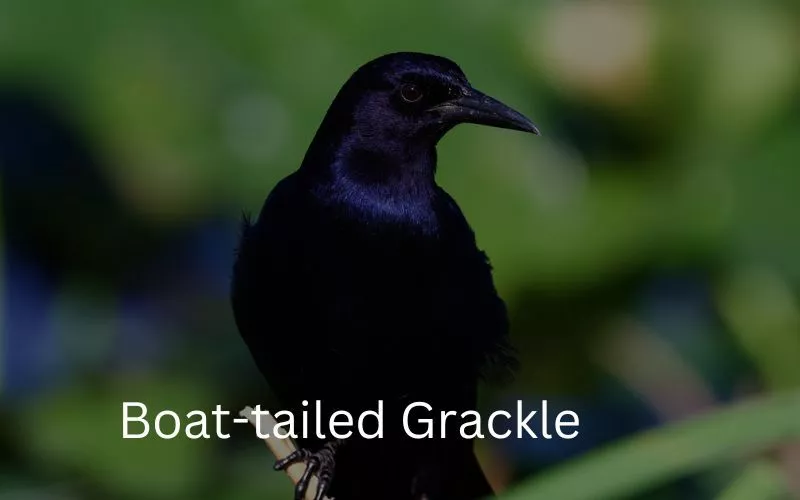
| Characteristic | Description |
|---|---|
| Color | Males: Glossy black with a purple sheen; Females: Brown with darker wings |
| Size | About 15–17 inches tall |
| Wingspan | 15–19 inches wide |
| Beak | Long, pointed beak |
| Habitat | Wetlands, marshes, coastal areas |
| Diet | Insects, small fish, seeds, and grains |
| Behavior | Often seen in noisy flocks, roosts in large groups |
| Flight Style | Direct flight with steady wingbeats |
| Voice | Loud, varied calls, including whistles and creaks |
| Common in Florida? | Yes, it is widespread throughout the state. |
The boat-tailed grackle is a bird of the family Icteridae. It was first described by French naturalist Louis Jean Pierre Vieillot in 1819.
The boat-tailed grackle male is large, with long legs, a long pointed bill, and V-shaped tails, while females have long bills and long tails. Females have a dark brown color on their lower bodies.
Size: Boat-tailed grackles can grow up to 10 to 15 inches in length, weigh up to 250 grams, and have a wingspan of almost 50 cm.
Habitat: Boat-tailed Grackles live across Florida and on inland waters. They prefer to stay in trash bins, dumpsters, and parking lots.
Diet: They are also known for stealing food from other birds. They are omnivorous and eat insects, frogs, eggs, seeds, berries, grain, and even small birds.
Related: What Bird is Only Found in Florida?
4. Black Birds in Florida: Brewer’Brewer’sird

| Characteristic | Description |
|---|---|
| Color | Males: Glossy black with a purplish-green sheen; Females: Brownish-gray with darker wings |
| Size | About 8–10 inches tall |
| Wingspan | 14–16 inches wide |
| Beak | Short, straight beak |
| Habitat | Open fields, parks, and urban areas |
| Diet | Insects, seeds, grains, and fruits |
| Behavior | Often seen in flocks, forages on the ground |
| Flight Style | Direct flight with rapid wingbeats |
| Voice | Sharp “chuk,” “alls,”and short whistles |
| Common in Florida? | Rare, mainly seen during migration or in winter |
The Brewer’Brewer’sirds are medium-sized black birds in Florida and other North America.
Male Brewer’Brewer’sirds have glossy black plumage with a blue-green sheen on their head and neck, while females have brown-grey plumage.
Size: Adults Brewer’Brewer’sirds can grow up to 10 inches long and weigh around 60 to 70 grams. Their wingspan ranges from 14-15 inches.
Habitat: The Brewer’Brewer’sirds prefer open habitats, such as agricultural fields, urban areas, and grasslands, and are often seen foraging with their large flocks in the ground.
Diet: During the breeding season, they prefer to eat beetles, caterpillars, grasshoppers, and insects. In the non-breeding season, they eat fruits, berries, and seeds.
Related: 4 Egrets in Florida
5. Black Birds in Florida: Rusty Blackbird

| Characteristic | Description |
|---|---|
| Color | Winter: Rusty brown; Breeding: Glossy black (males) |
| Size | 8–9 inches tall |
| Wingspan | 12–14 inches wide |
| Beak | Pointed, slightly curved |
| Habitat | Wetlands, swamps |
| Diet | Insects, seeds, small water creatures |
| Behavior | Forages on ground, often alone |
| Flight Style | Steady wingbeats |
| Voice | High-pitched, creaky calls |
| Common in Florida? | Uncommon, seen in winter |
The Rusty Blackbirds are medium-sized black birds in Florida with a short tail and a sharp beak.
Males have glossy black plumage with rusty edges on the feathers, while females have similar appearances but are slightly duller.
Size: Rusty Blackbirds can grow up to 9 inches long and weigh around 50 to 70 grams—their wingspan ranges between 12 to 15 inches.
Habitat: The rusty blackbird always prefers wetlands, including swamps, marshes, flooded woods, and the edges of lakes or ponds. They may be found in riverbanks, marshes, and flooded fields during winter.
Diet: The Rusty Blackbird feeds on insects and other small invertebrates. They also eat seeds, fruits, and berries.
Read More: 11 Birds that sing in the night in Florida
6. Black Birds in Florida: American Crow

| Characteristic | Description |
|---|---|
| Color | All black, including beak and legs |
| Size | 17–21 inches tall |
| Wingspan | 33–39 inches wide |
| Beak | Large, straight beak |
| Habitat | Forests, fields, urban areas |
| Diet | Omnivorous: insects, seeds, fruit, carrion |
| Behavior | Very social, often in groups |
| Flight Style | Strong, steady wingbeats |
| Voice | Loud “caw” c”lls |
| Common in Florida? | Yes, widespread across the state |
American Crows are medium-sized species of black birds in Florida. They are entirely black from the bill to the tail. This bird has large, long legs, a heavy bill, and short wings.
American Crowns are very social birds. They can solve challenging problems and can learn very quickly.
Habitat: American Crows primarily live in open fields, open woodlands, forests, agricultural fields, roadsides, towns, and even city garbage dumps.
Size: They can grow up to 21 inches long and weigh around 300 to 640 grams. Their wingspan is around 33 to 40 inches.
Diet: The American Crow is Omnivorous. They eat insects, carrion, human food, different types of fruits, walnuts, grains, almonds, seeds, eggs, nestlings, fish, and even prey on mice, young rabbits, frogs, and other small animals.
Related: 25 Brown Birds in Florida
7. Black Birds in Florida: Shiny Cowbird

| Characteristic | Description |
|---|---|
| Color | Males: Glossy black; Females: Brownish-gray |
| Size | 7–8 inches tall |
| Wingspan | 12–13 inches wide |
| Beak | Parasitic breeder lays eggs in other birds’ nests |
| Habitat | Open areas, fields, and urban regions |
| Diet | Insects, seeds, grains |
| Behavior | Yes, especially in the southern parts |
| Flight Style | Direct with quick wingbeats |
| Voice | High-pitched, short calls |
| Common in Florida? | Yes, especially in southern parts |
The shiny cowbirds are small black birds in Florida. You can quickly identify these blackbirds in the United States with their blackish-to-purple-blue mixed colors.
Males have a black and purple-blue color, while females have dull brown plumage.
Size: Shiny cowbirds can grow 18 to 22 cm long and weigh 30 to 65 grams.
Habitat: The Shiny Cowbirds always prefer to stay in parks, roadsides, farm fields, gardens, woodlands, and mangrove forests.
Diet: They mainly eat insects, seeds, grains, and other arthropods.
Related: When do Bluebirds Nest in Florida?
8. Black Birds in Florida: Great-tailed grackle

| Characteristic | Description |
|---|---|
| Color | Males: Glossy black with purple sheen; Females: Brown with darker wings |
| Size | 15–18 inches tall |
| Wingspan | 18–23 inches wide |
| Beak | Long, pointed beak |
| Habitat | Open areas, fields, and urban regions |
| Diet | Insects, small animals, seeds, and fruits |
| Behavior | Very social, often seen in noisy flocks |
| Flight Style | Direct with strong wingbeats |
| Voice | Loud, varied calls, including whistles and clicks |
| Common in Florida? | Rare, but sightings are increasing |
The Great-tailed grackles are known as Mexican grackles and are also known as black noisy birds in Florida.
There are 10 extant species of grackle, including the great-tailed grackle. These birds are usually found in Florida and other parts of the country.
Size: Great-tailed grackles are medium-sized birds that can grow 15 inches long and weigh around 115 to 210 grams. They have long legs, tails, and wingspans ranging between 20 and 23 inches.
Habitat: They prefer open habitats, such as grasslands, agricultural fields, wetlands, mangroves, scrub, and urban areas.
Diet: Great-tailed grackles are omnivorous. They eat many insects, snails, crayfish, small fish, lizards, eggs, and other small birds. They also eat different types of seeds, grain, berries, fruit, and nuts.
Related: Do Bluebirds Stay in Florida Year-round?
9. Black Birds in Florida: Common Grackle

| Characteristic | Description |
|---|---|
| Color | Iridescent black with blue or purple sheen (males); Brownish-black (females) |
| Size | 11–13 inches tall |
| Wingspan | 14–18 inches wide |
| Beak | Long, tapered beak |
| Habitat | Fields, woodlands, urban areas |
| Diet | Insects, seeds, grains, small animals |
| Behavior | Often seen in large, noisy flocks |
| Flight Style | Direct with strong wingbeats |
| Voice | Harsh, metallic “squeaks” and “creaks.” |
| Yes, it is widespread throughout the state | Yes, widespread throughout the state |
The common grackles are medium-sized black birds in Florida. Males have glossy black feathers with a blue or purple sheen, while females have more brownish-black on their body. Both males and females have yellow eyes.
Size: The common grackle can grow 12 inches long and weigh between 70 and 150 grams. Its wingspan is up to 18 inches. Males are more significant than females.
Diet: Common Grackles are omnivorous, eating insects, fruits, seeds, human food, and vertebrates. They also eat agricultural grains.
Habitat: They are found in urban and suburban areas, woodlands, agricultural fields, and wetlands. They also prefer to stay near water sources like streams or ponds.
10. Black Birds in Florida: Common Gallinule
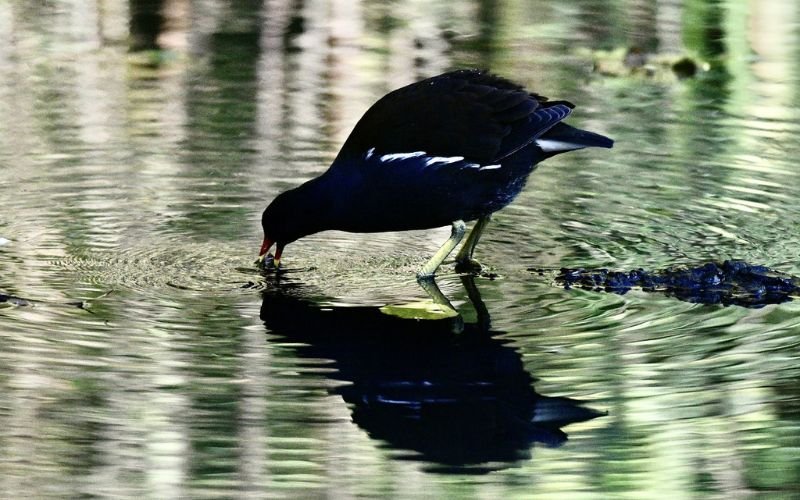
| Characteristic | Description |
|---|---|
| Color | Dark brown with a greenish sheen; white belly, bright red bill with yellow tip |
| Size | About 10–15 inches tall |
| Wingspan | 18–22 inches wide |
| Beak | Red with yellow tip |
| Habitat | Wetlands, marshes, and ponds |
| Diet | Seeds, insects, aquatic plants |
| Behavior | Often seen walking on floating vegetation or swimming |
| Flight Style | Short, flapping flights |
| Voice | High-pitched, harsh calls |
| Common in Florida? | Yes, especially in wetland areas |
Common Gallinules are medium-sized black birds in Florida. They have long legs, small heads, thin necks, long toes, and small bills.
Common Gallinules have grey and black color combinations on their body and red on their forehead. This bird species can swim like a duck and walk on the earth.
Habitat: They always prefer to stay near freshwater, ponds, lakes, and sometimes open water sources. They are also found in ditches, canals, and fields.
Size: Common Gallinules can grow up to 14 inches long, weigh around 450 grams, and have a wingspan between 50 to 65 cm.
Diet: They are Omnivorous. They eat leaves, seeds, different water plants, steam, fruits, and berries. It also eats small insects, spider nails, tadpoles, carrion, and eggs of other birds.
11. Black Birds in Florida: Double-crested Cormorant

| Characteristic | Description |
|---|---|
| Color | Black with a greenish sheen; two small crests on head during breeding |
| Size | About 30–36 inches tall |
| Wingspan | 45–55 inches wide |
| Beak | Long, hooked beak |
| Habitat | Lakes, rivers, coastal areas |
| Diet | Fish, amphibians, and aquatic invertebrates |
| Behavior | Often seen drying wings after diving |
| Flight Style | Direct with slow, steady wingbeats |
| Voice | Soft, low-pitched grunts |
| Common in Florida? | Yes, widely found across the state |
The double-crested Cormorant is a dark black bird species found in Florida. This water bird has a thin neck, long legs, enormous black wings, and a long beak. It can swim underwater.
Diet: They always prefer to eat fish, crabs, shrimp, crayfish, frogs, salamanders, eels, snakes, and plant material.
Habitat: They are found in lakes, rivers, bays, coasts, and small islands. They make nests near trees.
12. Black Birds in Florida: Red-winged blackbird

| Characteristic | Description |
|---|---|
| Color | Males: Black with red and yellow shoulder patches; Females: Brown and streaked |
| Size | About 7–9 inches tall |
| Wingspan | 12–16 inches wide |
| Beak | Short, conical beak |
| Habitat | Wetlands, marshes, fields, and grasslands |
| Diet | Insects, seeds, and grains |
| Behavior | Often seen in noisy, active flocks |
| Flight Style | Quick, direct with steady wingbeats |
| Voice | Sharp, varied calls, including “conk-l”-ree.” |
| Sharp, varied calls, including “conk-l”-ree” | Yes, especially in wetland and open areas |
If you live in Florida or are planning to visit Florida and don’t know about this red-winged blackbird, your life is wasted. An entirely black color body with red wings looks fantastic when they sit on trees.
Diet: Red-winged blackbirds mostly eat insects, seeds, beetles, caterpillars, grasshoppers, spiders, and snails. As well as grasses, weeds, grain, small fruits, and berries.
Habitat: Their habitat includes marshes, brushy swamps, forages, water edges, hayfields, fields, mudflats, farm fields, and pastures.
13. Black Birds in Florida: Anhinga

| Characteristic | Description |
|---|---|
| Color | Black body with white wings; long, slender neck |
| Size | About 28–36 inches tall |
| Wingspan | 39–47 inches wide |
| Beak | Long, straight, and pointed |
| Habitat | Wetlands, rivers, lakes, and coastal areas |
| Diet | Fish and amphibians |
| Behavior | Often seen swimming with just the neck and head above water |
| Flight Style | Steady flight with slow wingbeats |
| Voice | Soft, low-pitched grunts and hisses |
| Common in Florida? | Yes, commonly found in wetland areas |
If we talk about black birds in Florida, Anhinga is a perfect example. A long neck, a long tail, a black color lower body, and white and black combination wings look amazing.
Anhinga is one of the best-swimming blackbirds in the world. Sometimes, it swims with its neck and head above water, which is why it is called a ‘Snakeb’rd.’
Diet:‘They primarily eat fish. Also, sometimes they eat catfish, mullet, sucker, crayfish, shrimp, aquatic insects, snakes, baby alligators, and tiny turtles.
Habitat: These black birds in Florida always prefer rivers, wooded ponds, cypress swamps, sheltered waters, freshwater marshes, mangroves, and dead trees as their habitat.
14. Black Birds in Florida: American Coot

| Characteristic | Description |
|---|---|
| Color | Black with a white bill and frontal shield |
| Size | About 12–14 inches tall |
| Wingspan | 22–26 inches wide |
| Beak | White with a red or yellow tip |
| Habitat | Wetlands, ponds, and marshes |
| Diet | Aquatic plants, insects, and small invertebrates |
| Behavior | Often seen swimming or diving for food |
| Flight Style | Short, rapid flights with strong wingbeats |
| Voice | Harsh, high-pitched calls |
| Common in Florida? | Yes, especially in wetland and marshy areas |
The American coot is a water bird species primarily found in Florida and other parts of America. It can swim like ducks and walk about on the shore.
This species of blackbird is very noisy. They have big feet, strong legs, and long and robust beaks with red and white color.
Entirely black bodies with red eye combinations make them the most beautiful blackbirds ever found on earth.
Diet: American Coot is Omnivorous. They always prefer to eat stems, leaves, seeds, pondweeds, sedges, grasses, etc. They also eat tadpoles, fish, worms, snails, crayfish, and eggs.
Habitat: Ponds, lakes, marshes, park ponds, salt bays. They also prefer open habitats or ground near lakes and salt marshes.
15. Black Birds in Florida: Smooth-billed Ani
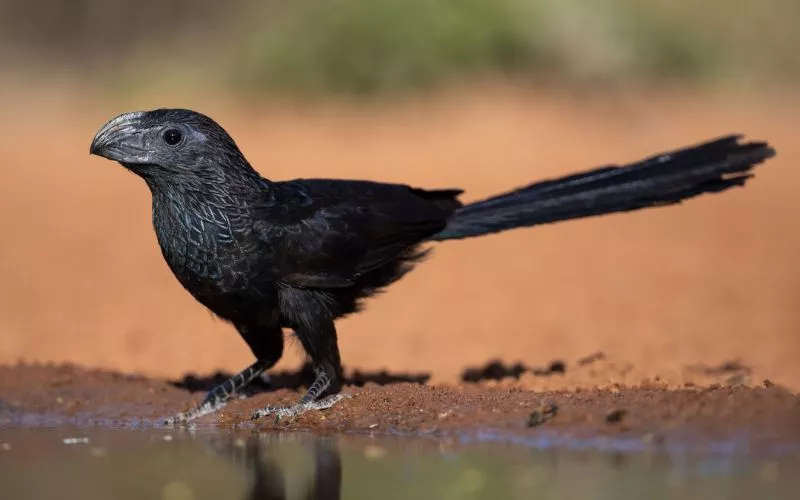
| Characteristic | Description |
|---|---|
| Color | Black with a greenish or purple sheen |
| Size | About 8–11 inches tall |
| Wingspan | 14–16 inches wide |
| Beak | Smooth, slightly curved and short |
| Habitat | Open woodlands, scrublands, and edges of forests |
| Diet | Insects, fruits, and seeds |
| Behavior | Often seen in small groups or pairs |
| Flight Style | Short, direct flights with rapid wingbeats |
| Voice | Varied, including harsh calls and whistles |
| Common in Florida? | Rare, mostly found in southern parts of the state |
Smooth-billed anis are black birds in Florida and are members of the Cuckoos family. Their Numbers increased through the middle part of the 20th century.
If you ever go to Florida, you will see these birds quickly. This medium-sized bird can grow up to 14 inches long and weigh around 115 grams.
Smooth-billed Ani has a glAniy back, long tail, and brown iris.
Diet: They eat insects, grasshoppers, beetles, moths, caterpillars, spiders, snails, and small lizards. Also, they eat eggs from other birds.
Habitat: Smooth-billed Ani habitat includes open fields, pastures, marshes, lowlands, and humid areas.
Conclusion:
In conclusion, Florida is home to many bird species with black colors, including grackles, black vultures, magnificent frigatebirds, brewer’brewer’sirds, and rusty blackbirds. Also, some migratory birds display their black colors during their breeding season. If you ever visit, you can see these 15 types of beautiful species of dark black birds in Florida.
Black Birds in Florida FAQs:
What is a Common Blackbird in Florida?
The boat-tailed grackles are the most common black birds in Florida. The Common Blackbird is not a native species to Florida but native to Europe and Asia.
What are the noisy black birds in Florida?
Grackles, boat-tailed grackles, common grackles, American crows, and great-tailed grackles are the noisiest black birds in Florida.
What black Florida bird looks like a crow?
Common Grackles and boat-tailed grackles are the only bird species that resemble crows. Also, the black bird that looks like a crow in Florida is most likely the Fish Crow.
What are the small black birds in large flocks in Florida?
Several species of small black birds form large flocks in Florida, but the most likely candidates are the Common Grackle and the European Starling.
What is the blackbird in the Florida Gulf?
Several blackbird species are found in the Gulf of Mexico region of Florida. The most common blackbird species found in this area is the Common Grackle.

